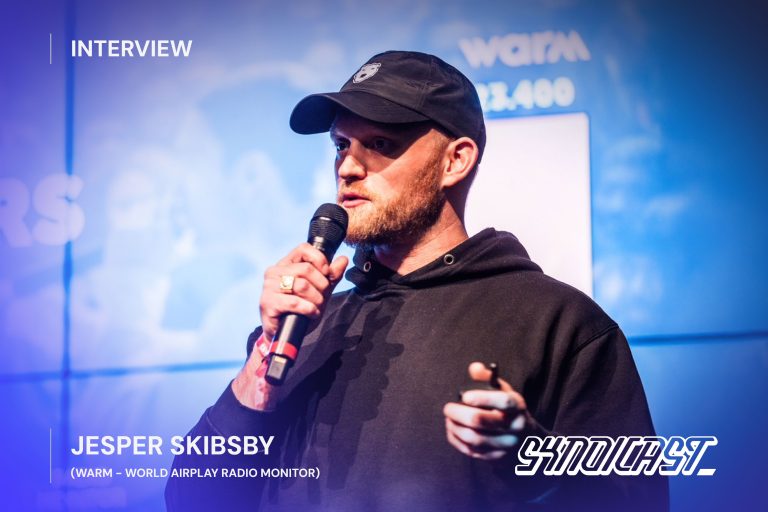It’s clear that today, artists can spread their music further than ever before – with almost infinite reach. However, this also makes discoverability more competitive.
While streaming data and social media metrics provide one part of the picture, the world of radio airplay – a powerful driver of discovery and royalties – has often remained a black box, especially for the independent community.
How can you track a song’s journey when its signal travels across borders, languages, and time zones?
Enter WARM (Worldwide Airplay Radio Monitor), the platform dedicated to solving this exact problem. Founded out of a direct need for transparent, global, and accessible radio data, WARM has become an essential tool for artists, labels, and managers looking to understand their true international footprint.
We had the privilege of sitting down with WARM’s founder, Jesper Skibsby, to dive into the company’s origin story. We discussed the roadblocks he faced, the surprising persistence of industry silos, and why radio remains a vital, human-curated force for breaking artists in the age of algorithms.
A New Collaboration: WARM Data, Now in Syndicast
This conversation is especially timely after our recent integration between our two platforms. We are now piping WARM’s real-time airplay data directly into Syndicast, creating a powerful new layer of insight for our users. This collaboration bridges the gap between digital promotion and terrestrial impact, allowing you to see precisely when and where your music is hitting the airwaves.
By pairing WARM’s radio analytics with your existing streaming and promo data, you can connect a spike in Shazams in a specific region directly to radio spins, informing tour routing, targeted marketing, and royalty collection with unprecedented accuracy.
Find out more about our WARM x Syndicast Collaboration.
Read on for our full conversation with Jesper and discover the vision behind the data.
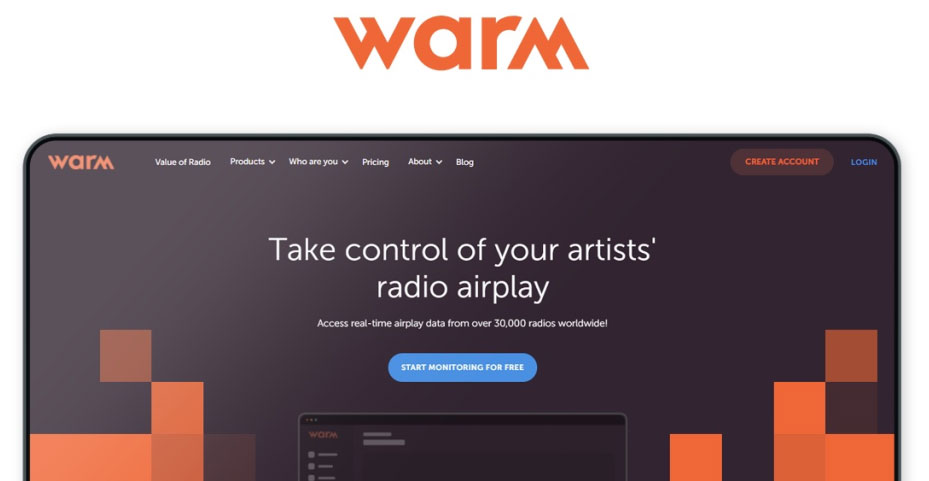
The WARM Origin Story
Welcome, Jesper, and thanks for joining us on the Syndicast blog! To start, what was the initial spark for creating a global radio airplay monitoring platform, and what specific problem did you see that wasn’t being solved?
The idea was born from my own experience back in 2014 when I was an independent manager and running a record label in Denmark. I discovered firsthand how difficult it was to access proper, accurate radio data. What was available was incredibly limited, siloed, and tailored to a major label approach.
Major labels have local offices everywhere, so they can work with localized data. But everyone else – the entire independent scene – was left without a way to get a global view. We needed worldwide data to discover emerging trends and find markets where our music was gaining traction organically. That was the specific gap we set out to fill.
Looking back, which roadblocks were the toughest to overcome – whether they were technical, business-related, or simply industry skepticism?
There have been plenty of challenges, especially when you start as a solo founder trying to manage every single aspect of a business. However, I’d say the biggest and most persistent challenge has been industry skepticism.
The music business, not just in radio, has many established figures who are naturally resistant to changing the systems and workflows they’ve used for years. But the tide is turning. We’re seeing more key companies and decision-makers recognize the true value that direct access to real-time data can unlock.
Ultimately, we’ve learned that the artists and teams who are willing to embrace this data are often the ones who achieve the biggest breakthroughs.
Milestones & Momentum
Can you share a statistic – whether it’s stations tracked, songs matched, or territories covered – that best captures WARM’s growth?
When we launched in 2017, we were monitoring around 12,000 radio stations. Today, that number is over 23,000.
But the raw number only tells part of the story. What’s more significant is that our growth has been strategic and driven by our customers. They help us prioritize adding the right stations in the most relevant markets. As a result, our coverage is now truly global, spanning from Japan and Australia to Latin America, the US, and Africa. We monitor everything from the biggest terrestrial and satellite broadcasters down to vital tastemakers like college, community, and specialist stations.
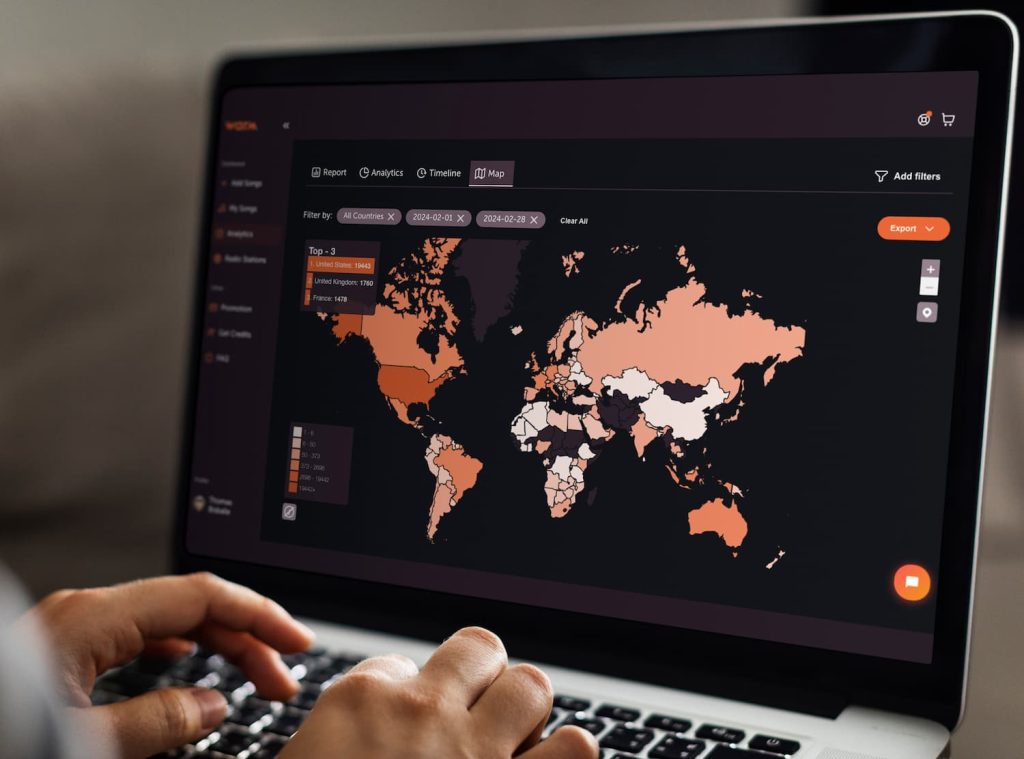
What have been the biggest surprises, or what are some things that have exceeded your expectations?
One of my biggest surprises is the persistent underestimation of radio’s power to break an artist globally. There’s such a heavy focus on TikTok and streaming platforms, especially among emerging artists, with the goal often being to “go viral.”
What gets forgotten is that radio is still driven by human curators – real people who are actively discovering and championing new music. For an independent artist, seeing your music get organic plays on multiple stations in different countries is an incredibly powerful signal.
On another note, the fact that major labels continue to operate in data silos is still mind-blowing to me. Their local offices often don’t have access to a comprehensive, global view of radio airplay, which is a massive strategic disadvantage.
Can you tell us about your new genre-based global radio charts for dance and urban music?
Absolutely. The reality is that music is distributed globally, but most radio charts are still local, commercial, and dominated by major labels. They often reflect airplay on just a handful of stations in a single country, which makes them irrelevant for most independent artists.
We wanted to change that. Our idea was to create genre-specific global charts by handpicking culturally important stations in niches like Dance or Urban music. This allows artists to see how they stack up against their peers on a global scale, not just in one country’s pop market.
We’ve now launched the Global Dance Radio Chart, the Global Urban Radio Chart, and most recently, a regional chart for Africa, all with the goal of creating a more transparent and fair environment for artists outside of mainstream pop.
The Business of Airplay Data
From PROs to label promo teams to indie managers, what are the three most common use-cases you see for WARM’s data?
We see our data being used in many ways, but three primary use-cases stand out:
- Promotion and Verification: Labels, artists, and managers use it to track the real-world performance of their radio promotion campaigns. It’s a powerful tool for verifying the results delivered by a radio plugger or PR firm.
- Royalty and Publishing Claims: The data serves as concrete evidence for PROs and publishers to ensure that artists are receiving the royalties they’re owed for airplay.
- Market Intelligence: This is a big one. Clients use the insights to identify organic growth in foreign markets, which helps them optimize tour routing, target marketing spend, and capitalize on unexpected opportunities.
Could you share a real-world example where timely airplay data directly affected an artist’s tour routing or marketing strategy?
Definitely. A great example is the NYC-based management for the electronic artist KREAM. They used WARM to identify a sudden, massive increase in airplay across several Eastern European countries. Armed with that specific data, they were able to confidently book shows and build a tour in a region they hadn’t previously prioritized.
Another case is the artist Tripolism, who saw their track “Dope Dance” having a breakthrough moment. Our data pinpointed that the overwhelming majority of this airplay was happening in Greece. This was a critical insight that immediately helped them understand their market value in that territory and focus their strategy accordingly.
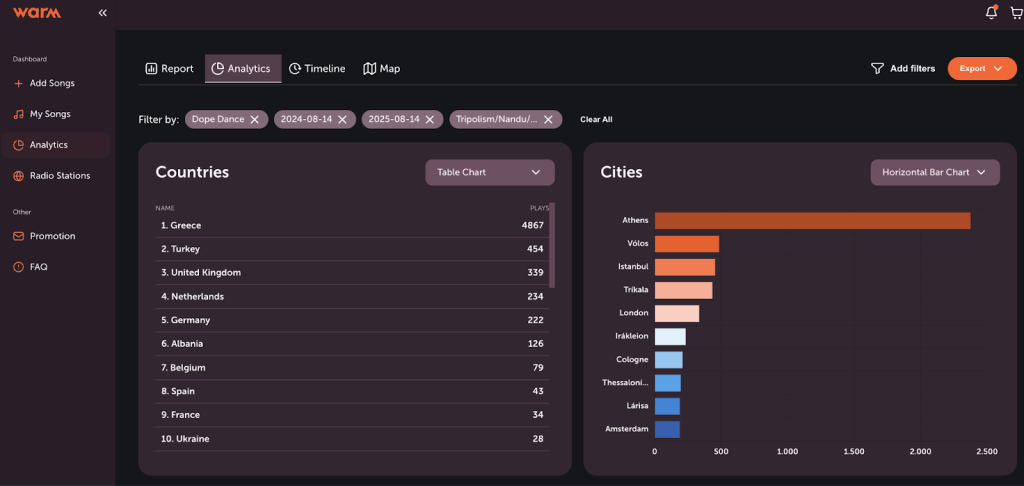
In theory, every station should be licensed and logged so artists always get paid. In practice, what’s still standing in the way?
That’s a common misconception. The issue today isn’t about stations being unlicensed—pirate radio is largely a thing of the past. The real roadblock is how Performance Rights Organizations (PROs) and Collective Management Organizations (CMOs) distribute the royalties they collect.
In most countries, payouts are based on detailed logs from only a small fraction of stations, often less than 20%. The vast majority of the money is distributed using methods like market-share analogies or sample testing, which disproportionately favors major artists.
I call it the “reverse Robin Hood” model: it takes from the many to give to the few. And unfortunately, this system is in place in nearly every country.
Industry Perspective
Streaming often grabs the headlines, but how healthy is radio really, and what niches or regions are seeing unexpected growth?
I may be biased, but I believe radio is healthier and more important than ever, particularly for breaking artists. Its real strength today lies in non-commercial music – genres like Dance, Jazz, and Alternative, where human curation still drives discovery.
There’s a fundamental disconnect in the industry right now. Music is distributed globally in an instant via streaming, but the promotional mindset, heavily influenced by the major label system, often remains stuck on local “home” markets. For an independent artist, this is a massive opportunity. If you only monitor radio in your own country, you are almost certainly missing out on organic growth in foreign markets. This is the new frontier, and radio data is the map.
What’s in the pipeline for WARM? Can you give us a teaser of any upcoming news?
Our biggest recent launch is something we’re very proud of: an official Top20 radio show based on our global dance radio chart, which we developed in partnership with Syndicast.
The show is now syndicated to over 44 dance music stations across multiple countries, reaching more than a million listeners every week—and it’s still growing. It’s a fantastic way to provide even more exposure and value to the artists and labels who make it into the Top 20.
Beyond the show, we’re seeing more industry leaders using our charts as a key resource, and we encourage anyone interested to sign up for the weekly newsletters on our website.
Integration With Syndicast
What excites you most about piping WARM’s real-time airplay data directly into the Syndicast platform?
I’m incredibly excited because this integration closes a major loop for music promotion. For Syndicast users, it means their campaign reporting becomes vastly more powerful and efficient. Instead of waiting for reports, they’ll have access to accurate, real-time radio airplay data right within the platform they already use every day.
It allows them to provide immediate, verifiable results to their clients and make faster, more informed decisions. For us, it’s a perfect partnership that brings our data directly to the industry professionals who can get the most value from it, solidifying our role as the trusted source for radio analytics.
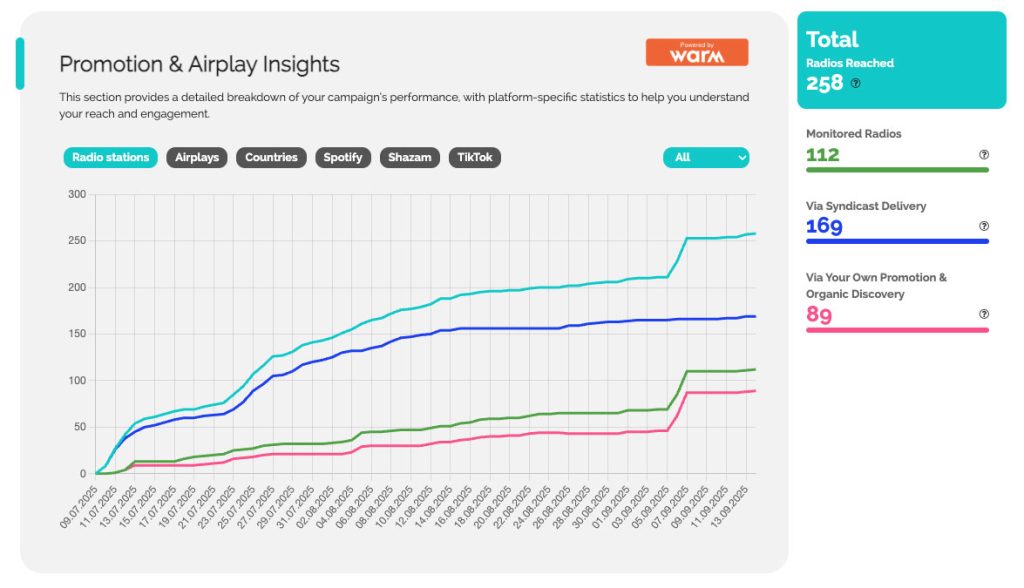
How will Syndicast users – many of whom are already deep in digital distribution and playlist pitching – benefit from pairing streaming analytics with live radio insights?
This is where it gets really powerful. Right now, many promoters are looking at streaming data in one place, social media trends in another, and radio reports somewhere else entirely. This integration brings a crucial piece of the puzzle – radio – into the same ecosystem.
Think about a common scenario: an artist’s track gets a sudden spike in Shazams in a specific city, like Berlin. By itself, that’s an interesting data point, but you don’t necessarily know why it happened. With WARM data integrated into Syndicast, you can immediately correlate that spike with a key DJ playing the track on a major Berlin radio station just moments before.
That direct, cause-and-effect insight is pure gold. You can use that intelligence to double down on marketing in that region, plan a tour date, or use it as concrete evidence when pitching the track to local DSP playlist editors. It connects the dots between offline broadcast and online engagement in a way that’s been very difficult to do until now.
Your Radio Data is Waiting.
The WARM integration is now live. It’s time to see the direct impact of radio airplay on your campaigns. Log in to Syndicast to activate your new superpower.
You can now monitor tracks outside of your Syndicast promotions using WARM’s direct service. This option is available for all new campaigns and can be enabled by clicking the button on your campaign interface or the banner within your PDF report.

